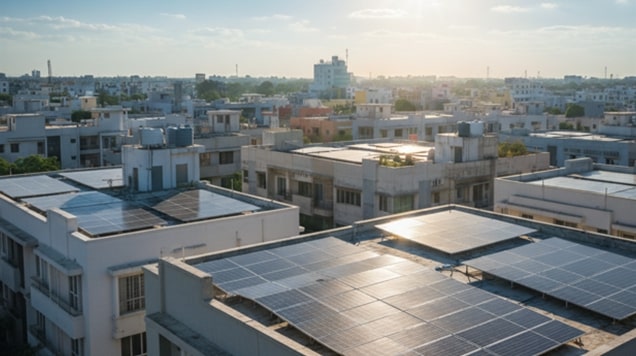Advantage: Rooftop Solar
Highlights of Rooftop Solar
Rooftop solar systems require lesser water when compared to ground-mounted solar power plants (for cleaning purposes). Plus, additional land acquisition, which is always the bane of any project, is not an issue with rooftop solar solutions. Off grid rooftop solar solutions reduce the requirement for large-scale transmission infrastructure for grid connectivity. Another problem that is tackled by on grid rooftop solar systems is that of under-utilization of the solar plant where the cost of building infrastructure to connect to the grid is much lower given the proximity to the grid.
Opting for ‘net metering’, while installing your rooftop solar system is extremely beneficial, when it comes to quicker ROI. What net metering does is, it calculates the amount of excess energy that you give back to the grid after consumption. The distribution company (discom) accordingly gives you a reduction in the monthly energy bill.
The crucial role of Discoms and state governments
Promoting any good initiative plays a crucial role in its success. For this reason, it is imperative that Discoms, along with state governments, strategise the promotion of solar rooftop systems. To top these efforts, the Government of India has to play a more active role in assisting state governments and discoms to expand the rooftop solar segment. It could begin with ensuring greater renewable purchase obligation compliance, carry out initiative to increase public awareness of the concept and deep dive into existing schemes to upgrade them and fine tune the challenges these schemes are currently facing.
From making these rooftop solar solutions more cost effective, to ultimately bringing down the costs through economies of demand, implementing quicker installation solutions, drafting favourable policies to ensure the growth of this sector, the path ahead is a long one for the Discom and state governments. Some short terms solutions, however, include drafting financial schemes with banks to make rooftop solar solutions affordable to one and all.
Way forward
India has recorded tremendous growth in the solar power sector – having grown its solar power capacity by almost 34 GW in a span of just 6 years! Yes! You heard right – India’s solar power capacity was 2.5 GW in 2014 and has grown to almost 36 GW in 2020. A big chunk of this is generated by ground-mounted solar plants and these are developed by the Government of India under the National Solar Mission. While rooftop solar installations form only about 6 GW, the Government of India has targeted to take this number up to 40 GW by 2022. Again, this goal can only reached by a massive increase in public awareness, faster installation processes and bringing down the overall cost of each plant.
Currently, the government has put in place capital subsidiary measures for consumers. Another measure that should act as a much needed boost in the arm, is the launch of the Sustainable Rooftop Implementation for Solar Transfiguration of India (SRISTI) scheme. This aim of this scheme is to motivate Discoms and consumers to opt for rooftop solar solutions over its counterparts. Unfortunately, all these measures took a beating due to the COVID-19 pandemic. Financial instabilities and disrupted supply chains caused a severe slow-down in the much needed growth of rooftop solar solutions – but as they say – tomorrow is another day!

